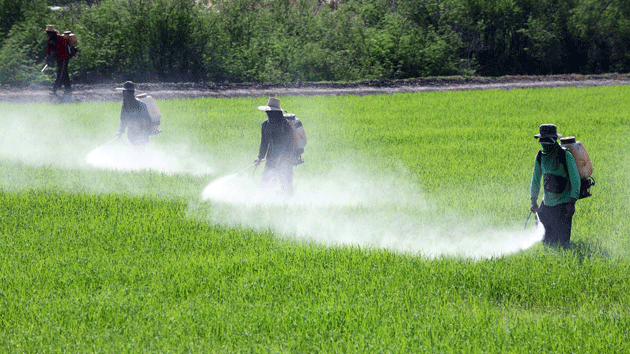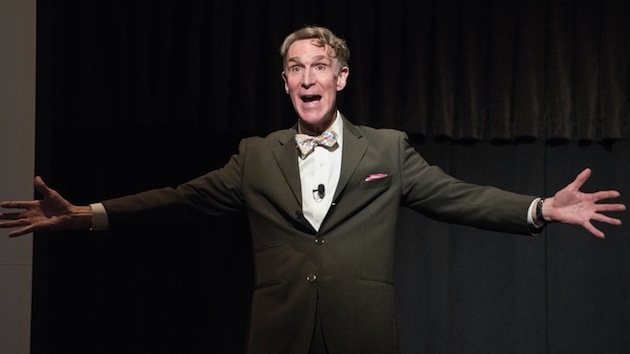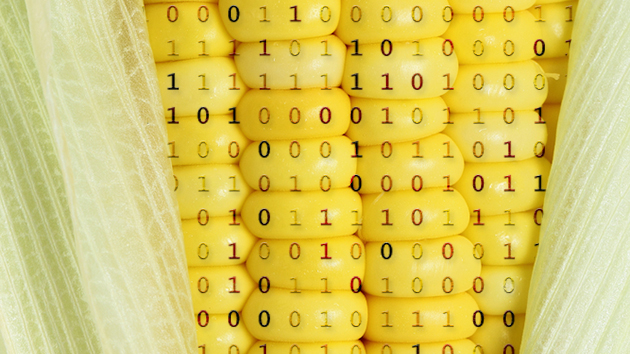
<a href="http://www.shutterstock.com/cat.mhtml?lang=en&language=en&ref_site=photo&search_source=search_form&version=llv1&anyorall=all&safesearch=1&use_local_boost=1&searchterm=pesticide&show_color_wheel=1&orient=&commercial_ok=&media_type=images&search_cat=&searchtermx=&photographer_name=&people_gender=&people_age=&people_ethnicity=&people_number=&color=&page=1&inline=129570608" target="_blank">sakhorn</a>/Shutterstock
Once an industrial-chemical titan, GMO seed giant Monsanto has rebranded itself as a “sustainable agriculture company.” Forget such classic post-war corporate atrocities as PCB and dioxin—the modern Monsanto “uses plant breeding and biotechnology to create seeds that grow into stronger, more resilient crops that require fewer resources,” as the company’s website has it.
That rhetoric may have to change, though, if Monsanto succeeds in buying its Swiss rival, pesticide giant Syngenta. On Friday, Syngenta’s board rejected a $45 billion takeover bid. But that’s hardly the end of the story. Tuesday afternoon, Syngenta’s share price was holding steady at a level about 20 percent higher than it was before Monsanto’s bid—an indication that investors consider an eventual deal quite possible. As The Wall Street Journal’s Helen Thomas put it, the Syngenta board’s initial rejection of Monsanto’s overture may just be a way of saying, “This deal makes sense, but Syngenta can hold out for more.”
The logic for the deal is simple: Syngenta is Monsanto’s perfect complement. Monsanto ranks as the globe’s largest purveyor of seeds (genetically modified and otherwise), alongside a relatively small chemical division (mainly devoted to the herbicide Roundup), which makes up just a third of its $15.8 billion in total sales.
Syngenta, meanwhile, is the globe’s largest pesticide purveyor, with a relatively small sideline in GMO seeds that accounts for a fifth of its $15.1 billion in total sales.
Combined, the two companies would form a singular agribusiness behemoth, a company that controls a third of both the globe’s seed and pesticides markets. To make the deal fly with US antitrust regulators, Syngenta would likely have to sell off its substantial corn and soybean seed business, as well its relatively small glyphosate holdings, in order to avoid direct overlap with Monsanto’s existing market share, the financial website Seeking Alpha reports. So the combined company would have somewhat smaller market share than what’s portrayed below:
In trying to swallow Syngenta, Monsanto is putting its money where its mouth isn’t—that is, it’s contradicting years of rhetoric about how its ultimate goal with biotech is to wean farmers off agrichemicals. The company has two major money-making GM products on the market: crops engineered to carry the insecticide Bacillus thuringiensis, or Bt, which is toxic to certain insects but not to humans; and crops engineered to withstand the herbicide glyphosate, an herbicide Monsanto sells under the brand name Roundup.
The company markets both as solutions to farmers’ reliance on toxic chemicals. Bt crops “allow farmers to protect their crops while eliminating or significantly decreasing the amount of pesticides sprayed,” Monsanto’s website declares; and its Roundup Ready products have” allowed farmers to … decrease the overall use of herbicides.”
Both of these claims have withered as Monsanto’s products have come to dominate US farm fields. Insects and weeds have evolved to resist them. Farmers have responded by unleashing a gusher of pesticides—both higher doses of Monsanto’s Roundup, and other, more-toxic chemicals as Roundup has lost effectiveness.
Monsanto’s lunge for Syngenta and its vast pesticide portfolio signals that the company thinks more of the same is in the offing.
One immediate winner would be the Monsanto’s formidable PR department. Battle-tested by years of defending the company from attacks against GMOs and also from the World Health Organization’s recent finding that glyphosate is “probably carcinogenic to humans,” the department would also find plenty of opportunity to flex its muscles if Syngenta came on board.
Syngenta is the main US supplier of the herbicide atrazine, which has come under heavy suspicion as an endocrine-disrupting chemical that messes with frogs’ genitalia and seeps into people’s drinking water. Syngenta is also one of two dominant purveyors of neonicotinoids—blockbuster insecticides (annual global sales: $2.6 billion) that have been substantially implicated in declining health of honeybees and other pollinators, birds, and water-borne animals. Both atrazine and neonics are currently banned in Europe, and widely, albeit controversially, used in the US.
All of which would make it ironic if, as some observers have speculated, Monsanto hopes to use the deal as an excuse to move its corporate HQ to Syngenta’s home base in Europe, in order to avoid paying US taxes.














